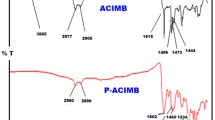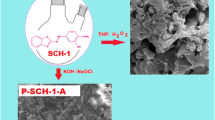Abstract
A series of Schiff bases were synthesized by condensation reaction of 3-aminopropyl(diethoxy)methylsilane with 3-hydroxybenzaldehyde and 4-hydroxy benzaldehyde compounds. Poly(imine)s were synthesized from Schiff bases by oxidative polycondensation. 2-Hydroxybenzaldehyde, 2-hydroxy-3-methoxybenzaldehyde and 2-hydroxy-1-naphthaldehyde were oxidatively polymerized using sodium hypochlorite (NaOCl) as oxidant, then poly(imine)s were grafted by adding 3-aminopropyl (diethoxy)methylsilane. Solubility tests of the synthesized Schiff bases and polymers were performed to determine the study conditions. All compounds were characterized by FT-IR, UV–Vis, 1H-NMR, 13C-NMR, CV and XPS analyses. Thermal properties of the synthesized compounds were determined using TG, DTA and DSC techniques. DMA analyses of polymers were performed to examine their T g values. The number-average molecular weight (M n ), weight average molecular weight (M w ) and polydispersity index (PDI) values of the synthesized compounds were determined by size exclusion chromatography. Photoluminescence (PL) properties of the synthesized compounds were determined in DMSO. Fluorescence measurements were carried out to obtain the maximum PL intensities. The cyclic voltammetry was an effective method to explore electrochemical (\(E_{\text{g}}^{'}\)) band gaps of the polymers. Four-point collinear probe was used to determine the electrical conductivities of both doped and undoped states of the synthesized polymers with respect to doping time with iodine. Combined with the good thermal stability, the morphologic properties of the polymers were illustrated using scanning electron microscopy images at different amplifications. The result of this study revealed that polysiloxanes containing imine linkages were crucial for π-conjugated polymers whose electronic composition and properties could be adjusted by side group. The highest conductivity was obtained for P4 polymerized using o-vanillin and 3-aminopropyl(diethoxy)methylsilane.














Similar content being viewed by others
References
Khuhawar MY, Mughal MA, Channar AH (2004) Synthesis and characterization of some new Schiff base polymers. Eur Polym J 40(4):805–809
Catanescu O, Grigoras M, Colotin G, Dobreanu A, Hurduc N, Simionescu CI (2001) Synthesis and characterization of some aliphatic–aromatic poly(Schiff base)s. Eur Polym J 37(11):2213–2216
Rostotskiy GA, Kulikova AK (1984) Pat Russia 1073239 Bull No 6
Anyunene IA, Baltushnikas AN, Liogony BI, Ragimov AV (1987) Investigation of thermostability of polyamide stabilized by polybetanaphthol. In: Abstracts of 26th republic conference polymer materials and their investigation, Vulnus, pp 56
Ionova ED, Asaturov SA, Ragimov AV (1981) Pat Russia No 841328
Ragimov AV, Babaev AA, Berlin AA (1976) Pat Russia No 513993 Bull No 18
Miroshin NF, Chubukov VN, Majer LA, Akutin MS (1973) Pat Russia No 363720 Bull No 4
Vermishyan GA, Akopyan SV (1979) Pat Russia No 686432
Ragimov GA, Mamedov AG, Ragimov AV (1981) Pat Russia No 888506
Kaya İ, Yıldırım M, Aydın A (2011) A new approach to the Schiff base-substituted oligophenols: the electrochromic application of 2-[3-thienylmethylene]aminophenol based co-polythiophenes. Org Electron 12(1):210–218
Satyananda B, Bletzacker T, Skene WG (2012) π-conjugated fluorescent azomethine copolymers: opto-electronic, halochromic, and doping properties. Macromolecules 45(3):1165–1173
Adhikari B, Majumdar S (2004) Polymers in sensor applications. Prog Polym Sci 29:699–766
Bai H, Shi G (2007) Gas sensors based on conducting polymers. Sensors 7:267–307
Jarzabek B, Kaczmarczyk B, Sek D (2009) Characteristic and spectroscopic properties of the Schiff-base model compounds. Spectrochim Acta A 74(4):949–954
Iwan A, Sek D (2008) Processible polyazomethines and polyketanils: from aerospace to light emitting diodes and other advanced applications. Prog Polym Sci 33(3):289–345
Kaya İ, Yıldırım M (2007) Synthesis, characterization, thermal stability and electrochemical properties of poly-4-[(2-methylphenyl)iminomethyl]phenol. Eur Polym J 43(1):127–138
Jarzabek B, Weszka J, Hajduka B, Jurusik J, Domanski M, Cisowski J (2011) A study of optical properties and annealing effect on the absorption edge of pristine- and iodine-doped polyazomethine thin films. Synth Met 161(11–12):969–975
Iwan A, Palewicz M, Sikora A, Chmielowiec J, Hreniak A, Pasciak G, Bílski P (2010) Aliphatic–aromatic poly(azomethine)s with ester groups as thermotropic materials for opto(electronic) applications. Synth Met 160(17–18):1856–1867
Kaya İ, Yıldırım M, Avcı A (2010) Synthesis and characterization of fluorescent polyphenol species derived from methyl substituted aminopyridine based Schiff bases: the effect of substituent position on optical, electrical, electrochemical, and fluorescence properties. Synth Met 160(9–10):911–920
Abe Y, Gunji T (2004) Oligo- and polysiloxanes. Prog Polym Sci 29(3):149–182
Plueddemann EP (1991) Silane coupling agents, 2nd edn. Plenum, New York
Plueddemann EP (1992) Reminiscing on silane coupling agents. In: Mittal KL (ed) Silanes and other coupling agents. VSP, Utrecht, pp 3–19
Eklund T, Bäckmann J, Idmann P, Norström AAE, Rosenholm JB (2000) In: Mittal KL (ed) Silanes and other coupling agents, vol 2. VSP, Utrecht, p 55
Zhu D, Ooij WJV (2004) Enhanced corrosion resistance of AA 2024-T3 and hot-dip galvanized steel using a mixture of bis- triethoxysilylpropyl]tetrasulfide and bis- trimethoxysilylpropyl]amine. Electrochim Acta 49(7):1113–1125
Takamura N, Gunji T, Hatano H, Abe Y (1999) Preparation and properties of polysilsesquioxanes: polysilsesquioxanes and flexible thin films by acid-catalyzed controlled hydrolytic polycondensation of methyl- and vinyltrimethoxysilane. J Polym Sci Part A Polym Chem 37:1017–1026
Gunji T, Okonogi H, Sakan T, Takamura N, Arimitsu K, Abe Y (2003) Preparation and properties of organic-inorganic hybrid gel films based on polyvinylsilsesquioxane synthesized from trimethoxy(vinyl)silane. Appl Organomet Chem 17:580–588
Abe Y, Honda Y, Gunji T (1998) Preparation and properties of silicon-containing polymer hybrids from 3-methacryloxypropyltrimethoxysilane. Appl Organomet Chem 12:749–753
Gunji T, Shigematsu Y, Kajiwara T, Abe Y (2010) Preparation of free-standing films with sulfonyl group from 3-mercaptopropyl(trimethoxy)silane/1,2-bis(triethoxysilyl)ethane copolymer. Polym J 42:684–688
Abe Y, Shimano R, Arimitsu K, Gunji T (2003) Preparation and properties of high molecular weight polyethoxysiloxanes stable to self-condensation by acid-catalyzed hydrolytic polycondensation of tetraethoxysilane. J Polym Sci Part A Polym Chem 41:2250–2255
Reddy KR, Park W, Sin BC, Noh J, Lee Y (2009) Synthesis of electrically conductive and super magnetic monodispersed iron-oxide-conjugated polymer composite nanoparticles by in situ chemical oxidative polymerization. J Colloid Interf Sci 335:34–39
Zhang YP, Lee SH, Reddy KR, Gopalan AI, Lee KP (2006) Synthesis and characterization of core-shell SiO2 nanoparticles/Poly(3-aminophenylboronic acid) composites. J App Polym Sci 14:2473–2750
Reddy KR, Sin BC, Ryu KS, Kim JC (2009) Conducting polymer functionalized multi-walled carbon nanotubes with noble metal nanoparticles: synthesis, morphological characteristics and electrical properties. Synth Met 159:595–603
Ojani R, Raoof JB, Zamani S (2010) A novel sensor for cephalosporins based on electrocatalytic oxidation by poly(o-anisidine)/SDS/Ni modified carbon paste electrode. Talanta 81:1522–1528
Hassan M, Reddy KR, Haque E, Faisal SN, Ghasemi S, Minett AI, Gomes VG (2014) Hierarchical assembly of graphene/polyaniline nanostructures to synthesize free-standing supercapacitor electrode. Compos Sci Technol 98:1–8
Reddy KR, Hassan M, Gomes VG (2015) Hybrid nanostructures based on titanium dioxide for enhanced photocatalysis. Appl Catal A Gen 489:1–16
Reddy KR, Lee KP, Ju Y, Lee Y (2008) Self-assembly and graft polymerization route to monodispersed Fe3O4@SiO2-polyaniline core-shell composite nanoparticles: physical properties. J Nanosci Nanotechnol 8(11):5632–5639
Reddy KR, Lee KP, Gopalan AI, Kang HD (2007) Organosilane modified magnetite nanoparticles/poly(aniline-co-o-aminobenzenesulfonic acid composites: synthesis and characterization. React Funct Polym 67:943–954
Reddy KR, Lee KP, Gopalan AI (2008) Facile synthesis of conducting polymer-metal hybrid nanocomposite by in situ chemical oxidative polymerization with negatively charged metal nanoparticles. Mater Lett 62:1815–1818
Diaz FR, Moreno J, Tagle LH, East GA, Radic D (1999) Synthesis, characterization and electrical properties of polyamines derived from selenophene. Synth Met 100:187–193
Anderson DR (1974) In: Lee A (ed) Analysis of silicones, chapter 10. Wiley, New York
Bellamey LJ (1975) The infra-red spectra of complex molecules, chapter 20, 3rd edn. Chapman and Hall, London
Lopez-Periago AM, Sandoval W, Domingo C (2014) Chemical modification of nanometric TiO2 particles by anchoring functional silane molecules in supercritical CO2. Appl Surf Sci 296:114–123
Reddy KR, Gomes VG, Hassan M (2014) Carbon functionalized TiO2 nanofibers for high efficiency photocatalysis. Mater Res Exp 1(1):015012
Vendetti I, Fratoddi I, Palazzessi C, Prosposito P, Casalboni C, Cametti C, Battachio C, Polzonetti G, Russo MVJ (2010) Self-assembled nanoparticles of functional copolymers for photonic applications. J Colloid Interf Sci 348:424–430
Louette P, Bodino F, Pireaux JJ (2005) Poly(ethylene terephthalate) (PET) XPS reference core level and energy loss spectra. Surf Sci Spectra 12(1):54
Colladet K, Nicolas M, Goris I, Lutsen I, Vanderzande D (2004) Low-band gap polymers for photovoltaic applications. Thin Solid Films 451:7–11
Cervini R, Li XC, Spencer GWC, Holmes AB, Moratti SC, Friend RH (1997) Electrochemical and optical studies of PPV derivatives and poly(aromatic oxadiazoles). Synth Met 84:359–360
Bilici A, Kaya İ, Yıldırım M, Doğan F (2010) Enzymatic polymerization of hydroxy-functionalized carbazole monomer. J Mol Catal B Enzym 64:89–95
Chen JC (2011) Synthesis, characterization and hydrolysis of aromatic polyazomethines containing non-coplanar biphenyl structures. Polymer 52:954–964
Grigoras M, Catanescu CO (2004) Imine oligomers and polymers. J Macromol Sci Part C Polym 44:131–173
Yıldırım M, Kaya İ (2012) A comparative study of aminothiazole-based polymers synthesized by chemical oxidative polymerization. Synth Met 162:436–443
Solmaz R, Kardas G (2009) Electrochemical synthesis and characterization of poly-2-aminothiazole. Prog Org Coat 64:81–88
Tang W, Kietzke T, Vemulamada P, Chen ZJ (2007) Synthesis, characterization, and photovoltaic properties of novel conjugated copolymers derived from phenothiazines. J Polym Sci A Polym Chem 45:5266–5276
Author information
Authors and Affiliations
Corresponding author
Rights and permissions
About this article
Cite this article
Kaya, İ., Çıtakoğlu, N. & Kolcu, F. Synthesis and characterization of semi-conductive, thermally stable imine polymers containing methyl silane group. Polym. Bull. 74, 1343–1369 (2017). https://doi.org/10.1007/s00289-016-1780-6
Received:
Revised:
Accepted:
Published:
Issue Date:
DOI: https://doi.org/10.1007/s00289-016-1780-6




